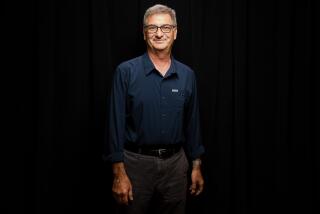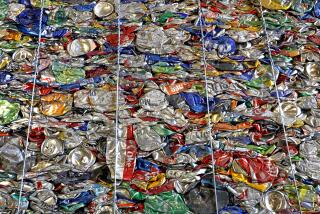New Machine to Gobble Up Trash Is Goal of Contest
- Share via
SACRAMENTO — WANTED: A vehicle with an insatiable appetite for roadside trash--paper, bottles, cans--capable of performing its task in a variety of circumstances efficiently and economically.
That may sound like a tall order, but Assemblyman Larry Stirling (R-San Diego) says he believes he knows how to fill it: Appeal to youthful ingenuity through what he calls the “Garbage Gobbler” design contest.
The contest, co-sponsored by Anheuser-Busch and the California Beer Wholesalers Assn., offers a $5,000 “reward” to the college student who designs a garbage collector versatile enough to clean the nooks and crannies of landscaped freeway shoulders as well as public beaches and parks.
“What we need is an efficient and economical automated system for abating (the litter problem). However, no such animal exists,” said Stirling.
Because of costly research and development, he said, private industry has not shown interest, leaving California, the champion of high-technology, stumped for an answer.
“We’re picking up trash the same way we’ve been doing it for thousands of years--with our hands,” he said.
After running into several dead ends in getting his idea launched, Stirling called on the brewery and distributing company.
“It looked like a good thing, and we’re for anything that is a promotion for litter cleanup,” said Tom Aldrich, vice-president and corporate representative for Anheuser-Busch, which with the wholesalers group agreed to sponsor Stirling’s contest.
A record 155,000 cubic yards of litter--enough to fill a convoy of dump trucks from Los Angeles to San Diego--were picked up from along California roadways in 1985, according to the state Department of Transportation.
Although most of the trash was the usual paper, bottles and cans, cleanup crews also found the head of a wild boar, a 5-foot-tall paper-mache rhinoceros, packages of illegal narcotics, a denture plate, sides of beef and a sailboat mast.
Like other states, California relies mainly on work crews, made of up minor offenders from the court system, to manually pick up roadside debris. Last year more than 600 persons picked up litter full time, costing taxpayers about $10 million.
“The method is quickly becoming outdated,” said Bill Dotson, district director of the Department of Transportation in San Diego.
“Because of the increased traffic, the amount of litter is increasing at a tremendous rate that’s almost impossible to keep up with,” he said.
Dotson said the creation of an all-purpose machine would not only get the job done more quickly, but would help the department redirect work crews to other needed tasks. “We could utilize these people for badly needed maintenance of freeways. It would certainly help our manpower,” he said.
With that in mind, Stirling embarked on his campaign, complete with illustrated posters depicting a hungry tractor gobbling a huge mound of garbage, by sending letters to college engineering departments inviting them to participate.
Iain Finnie, chairman of the mechanical engineering department at the University of California, Berkeley, called the contest “very worthwhile.”
“It just amazes me what students and young people come up with when given a challenge. We’ve had a lot of very ingenious students design a variety of items. I think we’ll find a number of students very interested,” he said.
Peter Lee, chairman of the civil engineering department at California State Polytechnical University, San Luis Obispo, also expressed optimism.
“I think it is a very good idea because students’ minds are more imaginative. They can always come up with some kind of unconventional idea and sometimes we need that,” he said.
But some doubt about the proposal was expressed by Charles Beadle, chairman of the mechanical engineering department at the University of California, Davis.
“Trash is a complicated problem. Tomatoes grow in a field (and can be picked by a machine) but beer cans and garbage are all over the landscape--on flat surfaces, steep shoulders, in gutters, behind trees. What is this magic machine that can go anywhere?”
Beadle said he believes “something can be done,” but said a more “realistic” approach is in order.
“You have to put a lid on how many types of garbage this machine can pick up. I just don’t believe there is a machine that can pick all of it up. Maybe I’m wrong. I hope I am,” he said.
More to Read
Sign up for Essential California
The most important California stories and recommendations in your inbox every morning.
You may occasionally receive promotional content from the Los Angeles Times.










